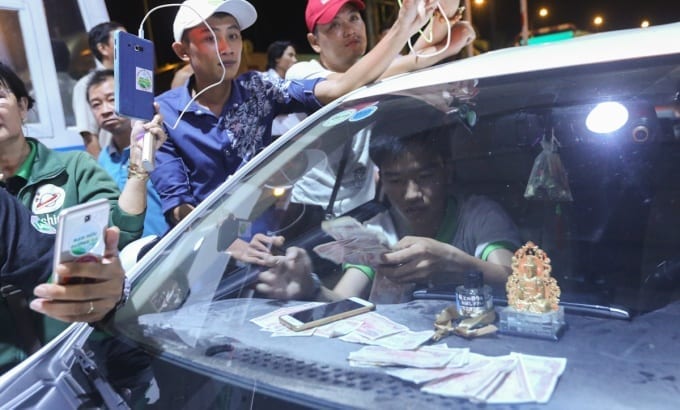
The smallest denomination banknotes in Vietnam, VND100 and VND200 ($0.01), are both available at the central bank to any individuals or organizations that have a demand for them, a senior official from the bank said.
Nguyen Thi Dam, director of the State Bank of Vietnam’s branch in Tien Giang Province, said the two notes are still in circulation and the central bank always makes sure they are available to customers.
Those in need can ask for small notes at any commercial bank or come to the central bank, she said on Friday.
Her statement follows a renewed dispute at a reopened toll station in Tien Giang where drivers have been protesting by demanding VND100 in change after paying VND25,100 for the VND25,000 toll.
The situation led to a massive tailback on Thursday running up to the Cai Lay station, forcing staff to give in and allow drivers through free of charge.
The station had only reopened that morning after disgruntled drivers forced it to close three months ago, but they were quick to pick up from where they left off.
Their previous tactic was to pay the toll with stacks of VND200 and VND500 notes, forcing staff to spend extra time counting them. This eventually resulted in heavy traffic jams which forced the station’s staff to let cars pass.
“We’re protesting because this station is in the wrong location, not because of the toll fees,” driver Vo Thanh Hao said. “We drivers will continue to fight against the investor behind the station.”
The branch in Tien Giang has asked the central bank to provide more VND100 notes, given the high demand for the small denomination at the moment.
In reality it’s a real challenge to find a VND100 note on the market these days, and they’re often kept as souvenirs now.
The VND100 note was issued in 1991, and the biggest denomination in Vietnam now is VND500,000 ($22). A cup of iced tea costs around VND2,000 at streetside stands.
The Cai Lay toll station was opened along National Highway 1 on August 1 for investors to recover the money spent on a project to resurface the highway and build a new bypass around a local town. However, drivers soon started using small change to pay the tolls in protest against the station, claiming it should have been placed along the new bypass instead of on the main road.
The protests resulted in heavy traffic for days, forcing the station’s operator to temporarily close it on August 15.
The Transport Ministry disagreed with the drivers’ claim that the station should have been placed along the new bypass, but agreed to cut the toll fees and let locals living near the station pass through for free.
Luu Van Hao, deputy chairman of the company investing in the BOT (Build-Operate-Transfer) project, also stressed that the toll station is operating in accordance with regulations.
“Cutting the toll fees is the last resort. We cannot relocate the station like the drivers have asked,” he said.
There are toll stations every 62 kilometers (39 miles) along the highway, according to a report released by the legislative National Assembly last year. The standard distance set by the government is 70 kilometers.

